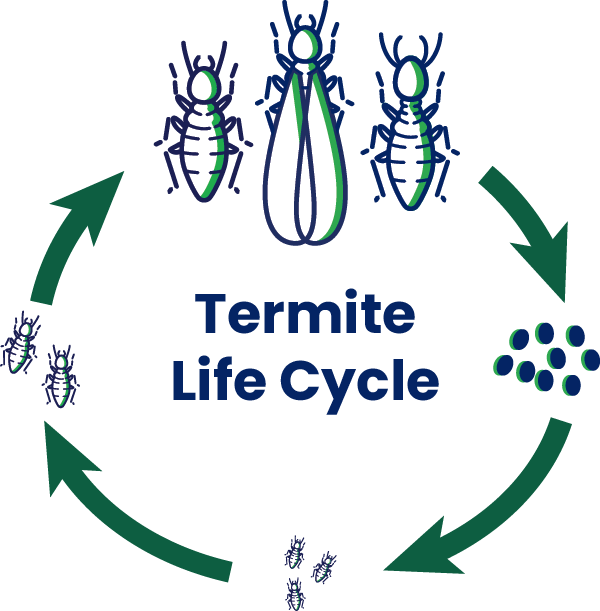Contributed by: Doug Webb
Updated: October 27, 2022
Understanding the life cycle of a termite can help you better comprehend how these pests may thrive in your home, as well as warning signs that you may have an infestation on your hands. Termites are part of a sophisticated society with specific castes and designations for each member, although the entire colony works to protect their young so they can become active adult members of the colony someday.
Learn more about the life cycle of a termite and how their evolution may impact your home and property, potentially causing costly damages.
Stages of the termite life cycle
Termites have three stages of growth. They begin their life cycle as eggs, which then hatches into nymphs (or young termites). Termite nymphs will molt several times before adulthood. Once they become adult termites, they take their place within the colony's caste system, which includes reproductive winged alates (or swarmers) that break away to form new colonies.

Egg
A termite queen, depending on species, may produce between 20,000 to 30,000 eggs per day. While the queen lays eggs, the entire termite colony cares for and protects the eggs because the eggs are necessary for the termite colony to thrive in the long-term.
Most of the eggs, when hatched, evolve to become destructive termite workers. Out of the various castes of termites, workers typically cause the most damage as they seek food for the colony and feed on the cellulose found in the wooden structures of your property.
Some of the eggs may become soldier termites, while others may become reproductive termites, also known as alates.
Nymph
When a termite egg hatches, a nymph emerges. A nymph is an immature termite. Termite nymphs are almost translucent and either white or a very pale shade of tan. At first glance, they look like maggots. However, upon closer inspection, nymphs have many of the features of fully grown termite, albeit on a smaller scale.
A termite nymph will go through a process of molting. At this stage, nymphs will develop an exoskeleton. The hard outer exoskeleton sheds off and the soft one beneath grows and hardens. This process may continue up to three times as the nymph matures, becoming larger and darker in color.
Termite nymphs do not eat through wood. Rather, worker termites feed them. Most of these nymphs soon grow into an adult termite and take their place as a working part of the termite colony that may feast on the wooden structure of your home.
Adult and caste designation
Termites are social insects that have a caste system. Once the termite is developed, it falls into one of several social classes. The classes include workers, soldiers, and reproductives. At the top of this hierarchy sits the queen, whose role is to lay eggs to ensure the future of the colony.
The queen has pheromones that control the development of other queens in the colony. If the colony is growing very fast, the queen may allow some nymphs to develop into secondary queens, so the egg-laying can keep up with the progress of the rest of the colony. If the queen dies, new queens develop because her pheromone dies with her.
Beneath the queen, within this caste system, worker termites are responsible for feeding the other termites, as well as building tunnels and chambers.
While worker termites are the architects and providers for the colony, soldier termites are the protectors. This class of termite has a larger head and mandibles for defense. They protect the colony against invasion.
And finally, there are the reproductive alates – the swarmer termites – that develop wings. They leave the nest to form new colonies, breaking their wings off once they've staked out a new territory.
Swarming
New termite colonies begin when winged swarmer termites, or alates, fly away from their home colony to start a new colony of their own. Colonies need to develop for some time, often years, before they produce swarmers of their own.
Hundreds or even thousands of termite swarmers may make the flight, never looking back, but only a few survive. Most swarmers become food for birds, toads, and other insects. Some die from injury or dehydration. Swarmers' wings are not very strong, so they need wind currents to carry them. If a swarmer survives, it finds a mate and loses its wings. The female becomes the new queen and a new colony begins, starting the entire process all over again as the queen lays new eggs.
Keep an eye out for termite swarms near your house. If you see one, it could be an indication that a termite infestation exists or that termites are setting up a new colony nearby on your property if not properly taken care of by a professional.
How long do termites live?
A termite's lifespan depends on its place in the social order of the colony. Termite life cycles vary widely from species to species, and also in terms of a termite's role within their colony. Worker and soldier termites can live between one to two years, while some termite queens can live for as long as 50 years.
Long live the queen
Queens of eastern subterranean termites, the most common species of termites found in the United States, can live up to a staggering 30 years, although a 15- to 17-year life span is more common.
For some African species of termites, a queen's life span may be up to 50 years, while in other species, such as drywood termites, the queens live only 10 to 12 years. In general, worker termites live about two years.
No matter what type they are or what point they are at in the termite life cycle, termites are trouble. If you think you may have spotted a termite or termite damage, contact Terminix today for termite control.


